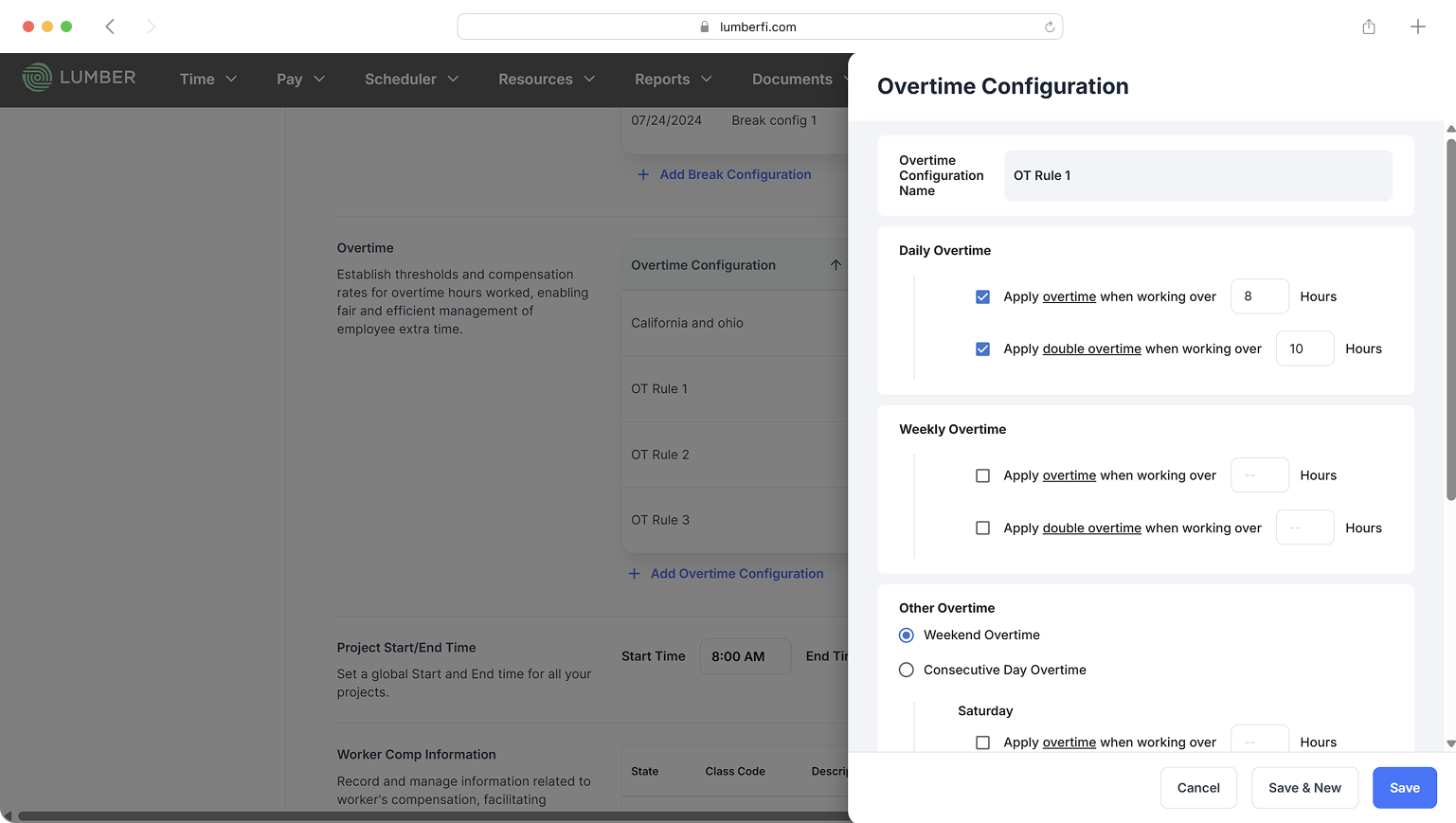Best Practices for Handling Overtime Pay in Construction
.jpg)
In the construction industry, managing overtime pay efficiently and accurately is crucial for ensuring compliance, controlling costs, and maintaining workforce morale. Construction projects involve complex time tracking and require precise application of overtime rules aligned with labor regulations. This guide outlines best practices for handling overtime pay, with a focus on construction-specific time tracking and overtime management features.

Construction Time Tracking: The Foundation
Accurate time tracking is the cornerstone of effective overtime management. In construction, time tracking systems must accommodate the unique demands of job sites, including variable work hours, multiple shifts, and diverse labor roles.
Implementing a Robust Time Tracking System
A reliable system should accurately record the actual clock-in and clock-out times for every worker, with the ability to accommodate adjustments for breaks, delays, and overtime.
Lumber Time Tracking offers a comprehensive digital solution specifically designed for construction sites, integrating mobile apps and biometric devices to enhance accuracy and minimize manual errors. For organizations, it can minimize reliance on manual timesheets, which often introduce inaccuracies and complicate overtime calculations, ensuring precise and efficient labor management.
.png)
Standardize Work Hours
Consistency in work hours across projects simplifies overtime calculations. Sets of standard start and end times, such as 8:00 AM to 5:00 PM, ensure uniformity. Establishing these times through software configurations helps in enforceable scheduling and monitoring.
Use Project-Specific Time Settings
Construction companies should leverage features that allow setting project start and end times globally. This configuration ensures all project activities adhere to a consistent schedule, aiding in uniform time tracking and facilitating easier calculation of regular hours versus overtime.
Construction Overtime Features and Configuration
.png)
The complexity of construction projects requires detailed overtime rules. Modern construction management platforms offer features that support flexible and precise overtime configurations.
Creating Detailed Overtime Policies
Organizations should establish clear overtime policies that align with labor laws and union agreements. These policies should specify thresholds for daily and weekly overtime. For example:
- Daily Overtime: Overtime applies after 8 hours per day.
- Weekly Overtime: Overtime applies after 40 hours per week.
- Double Overtime: May be applied after reaching certain thresholds, such as 12 hours per day or 60 hours per week.
- Special Rules: Weekend or holiday overtime rates if applicable.
Such rules should be configurable within the platform's overtime configuration section, allowing for tailored policies across different locations, teams, and roles.
Implementing Overtime Configuration
To set up overtime rules:
- Access the overtime configuration area within the system.
- Create a new configuration with a descriptive name, e.g., “Indiana Overtime.”
- Define daily thresholds, specifying after how many hours daily overtime kicks in.
- Set weekly thresholds for regular and double overtime.
- Include options for overtime rules on weekends or holidays, as needed.
- Assign these configurations to relevant sites, projects, or workers.
- Save and activate the rules.
Applying these configurations ensures uniformity, accuracy, and compliance across all projects.
Applying Overtime Rules Effectively
Once overtime rules are configured, they must be consistently applied to prevent discrepancies and disputes:
Monitor Work Hours in Real-Time: Utilize construction time tracking platforms that provide real-time monitoring capabilities. Supervisors can verify that workers’ hours are within limits and identify instances of overtime. Early detection prevents overpayment errors and helps manage labor costs effectively.
Automate Overtime Calculations: Automated systems apply configured thresholds to calculate overtime and double overtime precisely. This automation reduces manual calculation errors, ensures compliance with policies, and generates accurate payroll data.
Regularly Review Time Data: Periodic audits of timesheets and time logs ensure correctness. Confirm that workers’ recorded hours align with their actual work and that overtime is correctly identified and paid. Audits should be part of routine payroll processing.

Compliance and Fairness
Legal compliance and fairness are fundamental in overtime management:
Stay Updated on Labor Laws: Labor laws regarding overtime pay vary by jurisdiction and are subject to periodic changes. Regular updates to the system and policies are necessary to stay compliant.
Educate Supervisors and Workers: Ensure staff understand the overtime policies, including when overtime is paid, the applicable rates, and the process for requesting and recording overtime hours.
Transparent Overtime Processes: Clear, documented policies and transparent time tracking foster trust and reduce disputes. Workers should have access to their recorded hours and the overtime calculations.
Cost Control and Strategic Planning
Effective overtime handling balances cost control with operational needs:
Limit Unnecessary Overtime: Monitor patterns to identify excessive overtime. Address root causes, such as scheduling inefficiencies or resource shortages, to minimize unnecessary overtime.
Use Overtime Data for Planning: Analyze overtime trends to inform project planning and staffing. Accurate data helps in budgeting labor costs and optimizing workforce utilization.
Practical Examples of Overtime Configuration in Construction
For example, a construction company in Indiana might establish daily overtime to apply after 8 hours and weekly overtime to apply beyond 40 hours, in order to comply with state laws. They might also include double overtime pay for hours worked beyond 12 hours in a day or on Sundays. These precise rules can be configured on the Lumber platform and assigned to Indiana project teams, ensuring accurate tracking and fair pay.
A project in California may have different rules due to local labor laws, which could include applying overtime after 10 hours per day and special rates for weekend work. Using the flexible configuration feature, labor managers can assign these rules specifically to California crews.
Tools and Technologies for Construction Time Tracking
Modern construction projects benefit from integrating GPS and biometric time tracking tools. Mobile apps enable workers to clock in/out at the jobsite, while GPS tracking confirms their location, minimizing time theft and buddy punching. Wearable devices with biometric sensors can ensure that the right worker is logged, enhancing accuracy.
Cloud-based time tracking systems provide real-time data that is accessible to supervisors and payroll teams, streamlining overtime calculations and compliance checks. Integration with payroll software automates payment processing.
Overcoming Challenges in Overtime Management
Common challenges include managing unexpected overtime due to project delays, workers misreporting hours, or scheduling conflicts. Training supervisors to use time tracking technology and establish clear policies for overtime requests can help reduce errors and disputes.
Ensuring that overtime configurations reflect true work conditions requires close collaboration between HR, project managers, and payroll departments. Regular reviews and adjustments based on project feedback improve accuracy.

Benefits of Accurate Overtime Tracking
Accurate overtime tracking through Lumber prevents costly payroll errors and reduces the risk of labor disputes. It helps companies maintain good worker relations by ensuring fair compensation. Additionally, detailed overtime data can identify patterns that may require staffing or scheduling changes, enhancing overall project efficiency and cost management.
- Prevents costly payroll errors through automated overtime and double overtime calculations.
- Reduces labor disputes by ensuring fair and consistent compensation.
- Supports compliance with varying labor laws via customizable overtime rules for different projects and locations.
- Provides real-time tracking and reporting of overtime hours for immediate oversight.
- Identifies patterns of excessive overtime for better staffing and scheduling decisions.
- Enhances transparency by allowing workers to view their recorded hours and overtime calculations.
- Minimizes manual errors by eliminating manual timesheets and calculations.
- Improves workforce management through detailed overtime analytics.
- Contributes to better project cost control by monitoring and managing overtime expenses.
Final Recommendations
To implement best practices effectively, construction firms should:
- Invest in user-friendly, reliable time tracking technologies like Lumber that are suitable for mobile environments.
- Develop specific overtime configurations per location and project demands.
- Train all relevant personnel on overtime rules and system usage.
- Perform regular audits and use data analytics to improve labor management.
- Maintain transparent communication with employees regarding overtime policies and payments.
By following these guidelines, construction companies can manage overtime pay efficiently, reduce administrative burdens, and support project success.
Handling overtime pay in construction requires precision, compliance, and strategic oversight. Implementing detailed time tracking and flexible overtime configuration features allows construction firms to accurately compensate workers, monitor labor costs, and adhere to legal requirements. Consistent review, automation, and transparency are essential for effective overtime management, fostering fair treatment and operational efficiency.
Lorem ipsum dolor sit amet, consectetur adipiscing elit. Donec ullamcorper mattis lorem non. Ultrices praesent amet ipsum justo massa. Eu dolor aliquet risus gravida nunc at feugiat consequat purus. Non massa enim vitae duis mattis. Vel in ultricies vel fringilla.
Introduction
Mi tincidunt elit, id quisque ligula ac diam, amet. Vel etiam suspendisse morbi eleifend faucibus eget vestibulum felis. Dictum quis montes, sit sit. Tellus aliquam enim urna, etiam. Mauris posuere vulputate arcu amet, vitae nisi, tellus tincidunt. At feugiat sapien varius id.
Eget quis mi enim, leo lacinia pharetra, semper. Eget in volutpat mollis at volutpat lectus velit, sed auctor. Porttitor fames arcu quis fusce augue enim. Quis at habitant diam at. Suscipit tristique risus, at donec. In turpis vel et quam imperdiet. Ipsum molestie aliquet sodales id est ac volutpat.

Ipsum sit mattis nulla quam nulla. Gravida id gravida ac enim mauris id. Non pellentesque congue eget consectetur turpis. Sapien, dictum molestie sem tempor. Diam elit, orci, tincidunt aenean tempus. Quis velit eget ut tortor tellus. Sed vel, congue felis elit erat nam nibh orci.
Dolor enim eu tortor urna sed duis nulla. Aliquam vestibulum, nulla odio nisl vitae. In aliquet pellentesque aenean hac vestibulum turpis mi bibendum diam. Tempor integer aliquam in vitae malesuada fringilla.
Elit nisi in eleifend sed nisi. Pulvinar at orci, proin imperdiet commodo consectetur convallis risus. Sed condimentum enim dignissim adipiscing faucibus consequat, urna. Viverra purus et erat auctor aliquam. Risus, volutpat vulputate posuere purus sit congue convallis aliquet. Arcu id augue ut feugiat donec porttitor neque. Mauris, neque ultricies eu vestibulum, bibendum quam lorem id. Dolor lacus, eget nunc lectus in tellus, pharetra, porttitor.
Ipsum sit mattis nulla quam nulla. Gravida id gravida ac enim mauris id. Non pellentesque congue eget consectetur turpis. Sapien, dictum molestie sem tempor. Diam elit, orci, tincidunt aenean tempus. Quis velit eget ut tortor tellus. Sed vel, congue felis elit erat nam nibh orci.
Mi tincidunt elit, id quisque ligula ac diam, amet. Vel etiam suspendisse morbi eleifend faucibus eget vestibulum felis. Dictum quis montes, sit sit. Tellus aliquam enim urna, etiam. Mauris posuere vulputate arcu amet, vitae nisi, tellus tincidunt. At feugiat sapien varius id.
Eget quis mi enim, leo lacinia pharetra, semper. Eget in volutpat mollis at volutpat lectus velit, sed auctor. Porttitor fames arcu quis fusce augue enim. Quis at habitant diam at. Suscipit tristique risus, at donec. In turpis vel et quam imperdiet. Ipsum molestie aliquet sodales id est ac volutpat.
Mi tincidunt elit, id quisque ligula ac diam, amet. Vel etiam suspendisse morbi eleifend faucibus eget vestibulum felis. Dictum quis montes, sit sit. Tellus aliquam enim urna, etiam. Mauris posuere vulputate arcu amet, vitae nisi, tellus tincidunt. At feugiat sapien varius id.
Eget quis mi enim, leo lacinia pharetra, semper. Eget in volutpat mollis at volutpat lectus velit, sed auctor. Porttitor fames arcu quis fusce augue enim. Quis at habitant diam at. Suscipit tristique risus, at donec. In turpis vel et quam imperdiet. Ipsum molestie aliquet sodales id est ac volutpat.
- Lectus id duis vitae porttitor enim gravida morbi.
- Eu turpis posuere semper feugiat volutpat elit, ultrices suspendisse. Auctor vel in vitae placerat.
- Suspendisse maecenas ac donec scelerisque diam sed est duis purus.

Lectus leo massa amet posuere. Malesuada mattis non convallis quisque. Libero sit et imperdiet bibendum quisque dictum vestibulum in non. Pretium ultricies tempor non est diam. Enim ut enim amet amet integer cursus. Sit ac commodo pretium sed etiam turpis suspendisse at.
Tristique odio senectus nam posuere ornare leo metus, ultricies. Blandit duis ultricies vulputate morbi feugiat cras placerat elit. Aliquam tellus lorem sed ac. Montes, sed mattis pellentesque suscipit accumsan. Cursus viverra aenean magna risus elementum faucibus molestie pellentesque. Arcu ultricies sed mauris vestibulum.
Essential resources for contractors








